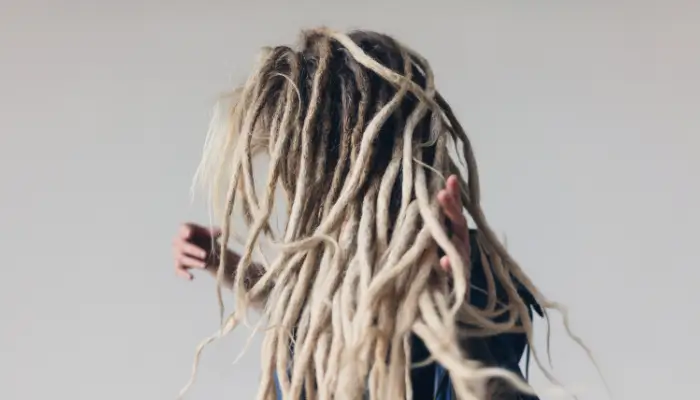Dreadlocks, also known as ‘locs,’ are a popular and trendy hairstyle that have been around for centuries. Originating from various cultures such as Greece, India, and Egypt, dreadlocks are essentially long matted ropes of hair that are twisted and knotted together. They vary in size, shape, and style, making them a unique and versatile hairstyle for anyone who wants to express themselves through their hair. Here in this section, we’ll explore the world of different types of dreadlocks, including popular styles, beginner-friendly options, and the advantages of each type.

Different Types of Dreadlocks Key Notes:
- Dreadlocks are a trendy hairstyle that originates from various cultures such as Greece, India, and Egypt.
- Dreadlocks are essentially long matted ropes of hair that are twisted and knotted together into different styles.
- There are various types of dreadlocks available, and each one has its own set of advantages and disadvantages.
- Understanding the different types of dreadlocks can help you make an informed decision about which hairstyle is best for you.
- Different types of locs require different maintenance techniques and products to keep them healthy and looking their best.
Popular Dreadlock Styles
Article – Human Hair Dreadlock Extensions
Dreadlocks have become increasingly popular over the years, and various styles have emerged to cater to different hair textures and preferences. In this section, we will explore some of the most popular dreadlock styles that people love to wear, including:
Traditional Locs
The traditional locs style is a classic and widely recognized dreadlock look. It involves allowing the hair to mat and knot naturally, without any specific modality for sectioning and defining the locks. The locs are large and cylindrical, providing a bold and durable look.
Sisterlocks
Sisterlocks consist of micro-sized locks that use a unique locking technique to create small sections of hair that are twisted and maintained long-term. This style provides more styling versatility than traditional locs, as the locs are smaller and more manageable.
Faux Locs
Faux locs are extensions added to natural hair to create the appearance of locs without actually growing them. This style is ideal for those who want to try out dreadlocks without a long-term commitment. Faux locs are available in various lengths, textures, and colors, giving a unique, trendy look.
Zen Locs
Zen locs use a unique braiding technique that includes gentle twisting of the hair rather than backcombing. The style employs elements of Japanese culture and philosophy to promote relaxation and peacefulness. This style is excellent for those with thin or shorter hair and provides a delicate, fringe-like appearance.
These popular dreadlock styles offer something for everyone. Whether you want a classic, bold look or a more subtle, refined style, there is a style that caters to your needs. The maintenance requirements for each style vary, but it is crucial to take good care of your hair to keep your locs healthy and beautiful.
Beginner-Friendly Dreadlock Styles
Beginner friendly dreadlock styles. If you’re interested in starting your dreadlocks journey, choosing a beginner-friendly style is crucial. Here are some options that are perfect for those who are new to the dreadlocks scene. Different Types of Dreadlocks:-
How to start and maintain dreadlocks:
| Style | Method | Description |
|---|---|---|
| Twist and Rip | Twisting and ripping hair strands | One of the most popular methods due to its simple and natural approach. It involves twisting and ripping hair strands into sections to create knots that eventually turn into dreadlocks. Twist and rip is an ideal option for short to medium-length hair and can be done at home with little effort. |
| Comb Coil | Using a comb to coil hair strands | Another simple method that is beginner-friendly and ideal for short hair. It involves using a comb to coil sections of hair tightly, which creates cylindrical locks similar to those created by twists and braids. It’s a great way to achieve a well-groomed look with minimal effort. |
| Interlocking | Intertwining hair strands with a special tool | This method requires more work than the previous two, but it yields longer-lasting results. Interlocking involves using a special tool to intertwine hair strands to create knots that will mature into dreadlocks. It’s suitable for all hair types, but it works best on thick and dense hair. |
Whichever method you choose, maintaining your dreadlocks is crucial to ensure their longevity. Cleanse your scalp regularly with natural shampoo and conditioner, and avoid using harsh chemicals or heat styling tools. It’s also essential to retwist your locs periodically and use a good-quality locking gel to maintain their shape and texture.

Maintenance Tips for Dreadlocks
Tips for styling and accessorizing dreadlocks. Dreadlocks require regular maintenance to keep them looking their best. To help with the upkeep of your locs, follow these essential maintenance tips for dreadlocks:
Wash regularly:
It’s important to wash your dreadlocks regularly to avoid build-up and maintain a healthy scalp. Use a sulfate-free shampoo and focus on massaging the scalp to cleanse it thoroughly. Avoid using too much product, as this can cause residue to build up.
Retwist:
Retwisting is an important aspect of dreadlock maintenance. This technique involves twisting your locs back into shape to keep them looking neat and tidy. Use a locking gel or cream to help with the process and twist in the direction of your existing pattern.
Palm roll:
Palm rolling is another technique used to keep your dreadlocks in shape. This technique involves rolling each lock between your palms to keep them tight and compact. You can do this technique on both wet and dry hair.
Use the right products:
Using the right products for your dreadlocks is crucial for their health and longevity. Look for hair products specifically designed for dreadlocks, such as locking gel, shampoo, and conditioner. Avoid using heavy oils that can cause build-up and damage your locs.
Protect your locs:
Protecting your dreadlocks while sleeping or during physical activities is important to avoid damage. Use a silk or satin pillowcase to prevent breakage and invest in a durag or headscarf to keep your locs in place. If you’re a swimmer, wear a swim cap to protect your locs from chlorine and salt water.
Trim regularly:
Regular trimming is important to avoid split ends and maintain the shape of your dreadlocks. Be sure to trim your locs every few months to keep them looking their best.
Pros and Cons of Different Dreadlock Types
Advantages of different dreadlock styles. The decision to get dreadlocks can be an exciting step towards embracing a new hairstyle, but it’s essential to consider the pros and cons of different dreadlock types before making a choice. Here we’ll analyze the main advantages and disadvantages of some of the most popular dreadlock styles.
Traditional Locks
The traditional method is often the preferred option for those who desire long-lasting, thick locs. However, it can take a long time to lock hair completely using this method, which might not suit those with much patience or those who want to change styles regularly. Traditional dreadlocks can be versatile for styling if well-maintained and offer a timeless, classic look.
Sisterlocks
Sisterlocks vary from traditional locks in that it involves smaller sections of hair, which creates a more refined look. They’re less bulky and take less time to lock; however, they are harder to install and may require more upkeep in between maintenance appointments. Sisterlocks can be versatile for styling and are generally low-maintenance, making them great for those with a busy lifestyle.
Freeform Locks
Freeform dreads give a more organic, natural aesthetic; however, as they form naturally, the process can take a long time. Also, they can be challenging to maintain, and the strands can break if not cared for correctly. Freeform locks offer the most versatility when it comes to styling.
Crochet Locks
Crochet locks require less time to install and can create tight, even-looking locs. However, this method may damage the hair if not done correctly or overused, and they can be difficult to adjust once installed. Crochet locks are easier to maintain than freeform locks, and they offer a consistent look that can be styled in numerous ways.
Comb Coils
This method produces coils by combing the hair and is a beginner-friendly option that doesn’t take as long as other methods. However, coils need to be regularly maintained to prevent them from unraveling, making them more high-maintenance than other types of dreads. Comb coils offer limited styling versatility, but they have a defined, neat look that suits many.
Interlocking
Interlocking is a method of using a specialized tool to “weave” an individual’s hair into dreadlocks. This approach forms locs faster than traditional methods; however, it can also cause thinner locs than other methods. Maintenance is less complicated than some of the other methods since the locks are tighter and easier to maintain. Interlocking can achieve both versatile and neat styles, depending on the individual’s preferences.
Ultimately, the choice of dreadlock style comes down to personal preference, lifestyle, and our hair’s unique characteristics. When opting for a specific method, ensure you understand your hair’s needs and the care that each style requires. With appropriate maintenance, you can rock any type of dreadlocks with confidence and style.
Tips for Styling and Accessorizing Dreadlocks
Now that you have chosen the perfect type of dreadlocks for yourself and maintained them well, it’s time to style and accessorize them to match your personality and fashion sense. Here are some tips to help you with that:
- Accessorize: Dreadlocks are a perfect canvas to showcase your creativity and love for accessories. You can add beads, shells, rings, feathers, or ribbons to your locs to enhance their beauty and add a personal touch to them.
- Experiment with styles: There are countless ways to style your dreadlocks, from updos and buns to half-up, half-down hairstyles and braids. Experiment with different styles to find out which one suits you the best and makes you feel confident and comfortable.
- Use natural products: To avoid the buildup of chemical products on your locs, it’s best to use natural products for styling, such as aloe vera gel, coconut oil, shea butter, or jojoba oil. These products will not only nurture your hair but also prevent it from frizzing or breaking.
- Protect your locs: When sleeping or exercising, it’s essential to protect your locs from tangling or breaking. You can wear a silk or satin scarf or bonnet to keep your hair in place and avoid frizz. Additionally, avoid wearing helmets or tight hats that can damage your locs.
- Be patient: Finally, remember that dreadlocks take time to develop and mature. It’s normal to feel frustrated or insecure during the early stages of your dreadlock journey, but don’t give up. With patience, persistence, and the right maintenance, your dreadlocks will grow into a beautiful and unique natural hair look.
By following these Different Types of Dreadlocks tips, you can embrace your dreadlocks confidently and creatively, knowing that they represent not only your fashion sense but also your self-expression and cultural heritage.
View the best products for dreadlocks on Amazon



